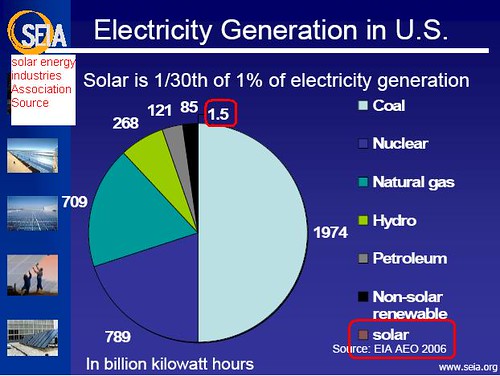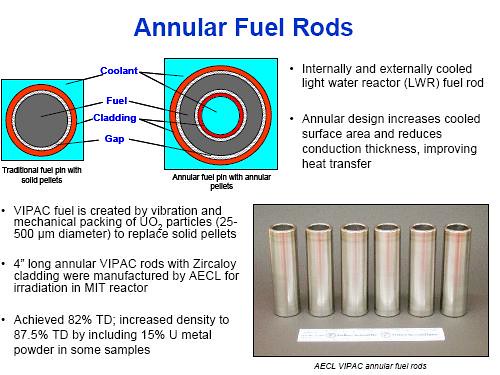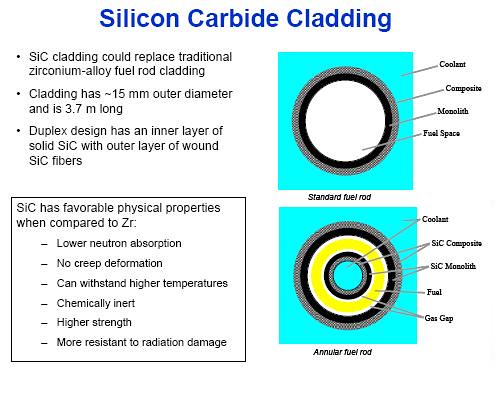MIT/Westinghouse are developing annular fuel and looking at nanoparticles to improve the thermal properties of water for nuclear plants. The peak hotspot operating temperature can go down while efficiency is increased. I usually mention this technology as something which would make a huge difference in nuclear power generation. I am reviewing the work and updating with some recent journal references.

Solar power is 1/30th of 1%. Boosting nuclear power by 50% would be like doubling hydroelectric and all renewable power. It would be 300 times all of the solar power in the USA in 2006.
The fuel is especially well suited for pressurized water reactors, which make up 60% of the world’s 443 reactors. Hejzlar says that utilities in the U.S., Japan, and South Korea have expressed interest in his design.
The annular fuel would boost power by 50%.
The nanoparticles in fluid would boost power by 20% for existing reactors and 40% for new reactors.
The cross shaped spiral design would boost boiler water reactors by 30%.
The MIT fuel is thin walled donuts with pellets inside and using nanoparticles in the fluid.

The tubes with uranium particles
The new design also helps diminish the chance of meltdown by slashing the temperature at which reactors must be operated, and it renders the spent fuel more proliferation-resistant.
Reactors that use the new fuel can operate at 700 °C—less than half of the 1800 °C required for conventional fuel. This takes the reactor temperature much farther away from the 2840 ° C at which meltdowns can occur. The temperature is so much lower because the doughnut shape enables heat to flow in two directions and the surface-area-to-volume ratio is about 60% higher, Hejzlar explains.
“A traditional fuel rod looks like a pencil, with the fuel pellets inside the tube and water flow on the outside of the tube. Annular fuel is like a thick-walled stra… or a very thin-walled doughnut,” explains Edward Lahoda, a nuclear engineer at Westinghouse Corp., a major manufacturer of pressurized water reactors.
The new fuel is much more complex to manufacture than conventional cylindrical pellets. But when Westinghouse made a test run of producing the annular pellets, they achieved a “very good yield” of greater than 95%, Lahoda says. “Manufacturing is not a trivial issue,” he stresses. “If you can’t make them in millions of pellets and load them into hundreds of thousands of rods, the concept is useless.”
In a three-year project completed recently [2006] for the U.S. Department of Energy, Hejzlar and Kazimi teamed up with Westinghouse and other companies to look at how to make a fuel for one kind of reactor, the pressurized water reactor (PWR), 30 percent more efficient while maintaining or improving safety margins. [the pilot study]
They changed the shape of the fuel from solid cylinders to hollow tubes. This added surface area that allows water to flow inside and outside the pellets, increasing heat transfer.
The new fuel turned out even better than Hejzlar dared hope. It proved to be easy to manufacture and capable of boosting the power output of PWR plants by 50 percent.
The next step is to commercialize the fuel concept, which will include testing a limited number of rods filled with the new pellets in an operating reactor and examining the results to ensure the safety and performance of the new fuel.
PWR Transition to a Higher Power Core Using Annular Fuel
The internally and externally cooled annular fuel is a new type of fuel for PWRs that enables an increase in core power density by 50% within the same or better safety margins as traditional solid fuel. Each annular fuel assembly of the same size dimensions as solid fuel has 160 annular fuel rods arranged in a 13×13 array. Even at the much higher power density, the fuel exhibits substantially lower temperatures and a Minimum Departure From Nucleate Boiling (MDNBR) margin comparable to that of traditional solid fuel at nominal (100%) power. The major motivation for such an uprate is reduction of electricity generation cost. Indeed, the capital cost per kWh(e) of a new reactor would be smaller than the standard construction of a new
reactor with solid fuel.This option implies running a core with a mixture of both annular and solid fuel assemblies. In order to prove the technical feasibility of such an option, the thermal-hydraulics of this mixed core is investigated and the MDNBR is found to be either unaffected or improved. Consequently, a neutronic model is developed to verify and validate the neutronic feasibility of the transition from solid to annular fuel. This involvements assessment of the peaking factors and capability to provide control poisons within allowable concentrations The overall conclusion of this work is that annular fuel is a very promising option for existing reactors to increase their power by 50%, as it enables a significant uprate with an attractive return on investment. We show that, by a smart management of the transition, an internal return investment of about 22–27% can be achieved.
Nanoparticle Spiked water
Nanofluid can boost PWR power by 20% for existing reactors and 40% for new reactors
Jacopo Buongiorno, assistant professor of nuclear science and engineering, has come up with a way to change water’s thermal properties. This change may contribute to plants’ safety while boosting their power density, or the amount of energy they can pump out.
The efficiency of PWRs and BWRs is limited to around 33 percent, because water can be heated to only a certain temperature and only a certain amount of heat can be taken out of water. If that limit were pushed higher, more heat could be extracted, and the plant would generate more energy at a lower cost.
His laboratory works on nanofluids — base fluids such as water interspersed with tiny particles of oxides and metals only billionths of a meter in diameter. Buongiorno’s nano-spiked water, transparent but somewhat murky, can remove up to two times more heat than ordinary water, making it an ideal substance for nuclear plants.
Nanoparticles in the water that cools the outer surface of the vessel raise the amount of heat that can be drawn away from the core, making the plant less susceptible to the negative repercussions of a possible meltdown.
The key issue to be resolved before nanofluids can be used in nuclear plants, Buongiorno said, is the stability of the nanoparticles, which could agglomerate and settle quickly if appropriate chemical and thermal conditions are not carefully maintained.

Silicon cladding would be tougher and safer than zirconium alloy on fuel rods
MIT work to improve boiler water reactor performance and safety

The EIA analysis of the effect of a climate change bill passing Two to three times more nuclear power from increased nuclear plant build. It does not consider the MIT work or the thermoelectrics.
On the changes of a climate change bill passing:
A bill is already in front of the Senate and >passed the senate committee.
Clinton and Obama would support a stronger climate change bill.
McCain co-authored the one analyzed by the EIA
The other republicans support nuclear power.
Michael Bloomberg has asked for a carbon tax which would have an even stronger effect than the climate change bill.
A lot of other work on improving nuclear reactor efficiency and performance.
Annular fuel special issue of American Nuclear Society 2007
Page 5 of Westinghouse 28 page 2004 worldview mentions the MIT 50% power uprate work

Brian Wang is a Futurist Thought Leader and a popular Science blogger with 1 million readers per month. His blog Nextbigfuture.com is ranked #1 Science News Blog. It covers many disruptive technology and trends including Space, Robotics, Artificial Intelligence, Medicine, Anti-aging Biotechnology, and Nanotechnology.
Known for identifying cutting edge technologies, he is currently a Co-Founder of a startup and fundraiser for high potential early-stage companies. He is the Head of Research for Allocations for deep technology investments and an Angel Investor at Space Angels.
A frequent speaker at corporations, he has been a TEDx speaker, a Singularity University speaker and guest at numerous interviews for radio and podcasts. He is open to public speaking and advising engagements.


Comments are closed.